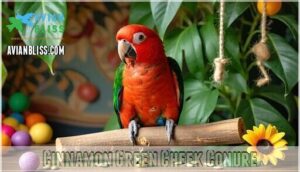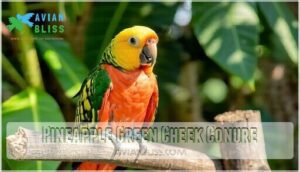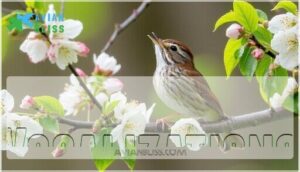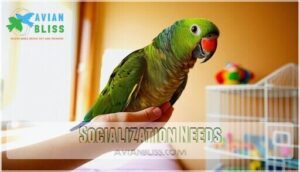This site is supported by our readers. We may earn a commission, at no cost to you, if you purchase through links.

These 10-inch South American parrots pack big personalities into small bodies, living up to 30 years when you provide proper nutrition, spacious housing, and daily interaction.
You’ll find them in stunning color mutations from classic green to vibrant pineapple varieties.
They’re quieter than larger parrots but still love to chatter and play.
Their intelligence means they need mental stimulation through toys, training, and social time.
With their playful nature and strong bonding ability, they make ideal companions for both beginners and experienced bird owners who want a manageable yet engaging pet.
Table Of Contents
- Key Takeaways
- Green Cheeked Conure Overview
- Conure Mutations and Colors
- Temperament and Behavior
- Caring for Green Cheeked Conure
- Health and Common Issues
- Frequently Asked Questions (FAQs)
- Are green cheek conures good pets?
- Can a green cheek conure talk?
- What are the disadvantages of a green cheek conure?
- Why are green-cheeked conures so expensive?
- Is a green cheek conure a good pet?
- Do green cheek conures talk a lot?
- How much does a green cheek conure cost?
- How long do green cheeked conures live?
- What are some common behavioral issues in green cheeked conures?
- Can green cheeked conures be trained to do tricks?
- Conclusion
Key Takeaways
- You’ll get a long-term companion – These birds live 20-30 years with proper care, so you’re making a decades-long commitment that requires consistent attention and interaction.
- They need daily mental stimulation – Your conure’s intelligence means you’ll need to provide toys, training, and social time to prevent destructive behaviors like feather plucking and excessive screaming.
- Proper nutrition is essential – You’ll need to feed balanced pellets plus fresh vegetables and limited fruits while avoiding toxic foods like avocado, chocolate, and caffeine.
- They’re quieter but still vocal – You’ll enjoy a chatty companion that can learn words and phrases without the overwhelming noise levels of larger parrots, making them apartment-friendly.
Green Cheeked Conure Overview
You’ll discover that green-cheeked conures belong to the Pyrrhura molinae species, small parrots measuring about 10 inches long with vibrant green plumage, distinctive red tail feathers, and those famous green cheek patches.
These intelligent birds originate from South America’s forests, particularly Bolivia, Brazil, and Argentina, where they’ve adapted to diverse woodland environments, making them a unique species with notable characteristics such as their vibrant green plumage.
These vibrant South American natives bring tropical forest charm straight to your home with their stunning emerald feathers and playful spirits.
Species Classification
Your green cheeked conure belongs to the genus Pyrrhura within the Psittacidae family, making it a true parrot species.
This small parrot’s evolutionary history traces back millions of years across South America.
Among related species, you’ll find over 20 Pyrrhura conures sharing similar traits.
While not endangered, habitat loss affects wild populations.
These conure parrots remain popular pet birds due to their manageable size and stunning conure colors.
Physical Characteristics
These compact conure parrots pack impressive features into their small frames.
Your green cheeked conure typically weighs 60-80 grams with a 10-inch length, making them perfect apartment companions.
Their vibrant plumage displays emerald wings, burgundy tail feathers, and distinctive green cheek patches.
Strong, curved beaks crack tough seeds effortlessly, while zygodactyl feet (two toes forward, two back) provide excellent gripping power.
With proper care, these small parrots live 20-30 years.
These birds possess lightweight, hollow bones which aid in flight.
Native Habitat
Adventure awaits those who understand where these vibrant parrots call home. Green cheeked conures thrive across their South American Range, inhabiting diverse Forest Ecosystems from Bolivia to Brazil.
Understanding their wild origins helps you provide better bird care at home.
Native habitat features:
- Dense rainforest canopies with abundant fruit trees
- River valleys and woodland edges for foraging
- Tree cavities for nesting and roosting
- Seasonal fruit availability affecting Wild Diet patterns
- Social flocks numbering 10-20 birds
Unfortunately, Habitat Loss threatens their Conservation Status, making captive breeding programs essential for species survival.
Conure Mutations and Colors
You’ll find that green-cheeked conures come in several stunning color mutations, each created through selective breeding for specific genetic traits.
These variations range from the classic wild-type coloration to vibrant yellows, warm cinnamons, and striking turquoise hues that’ll make your feathered friend stand out, showcasing their unique color mutations.
Normal Green Cheek Conure
The classic beauty showcases nature’s original artistry with vibrant emerald plumage and distinctive rusty-red cheek patches.
Wild ancestry traces back to South American rainforests where their natural diet consists of fruits, seeds, and vegetation.
These plumage details represent the species’ conservation status as stable in captivity.
Understanding green variations helps with proper bird care, conure diet planning, conure training approaches, conure cage setup, and interpreting conure behavior patterns effectively.
Yellow-Sided Green Cheek Conure
Yellow-sided conures showcase vibrant Color Intensity with brilliant yellow replacing traditional green on their chest and belly.
Yellow-sided conures dazzle with brilliant chest feathers that glow like tropical sunshine.
These stunning Yellow Variations result from specific Genetic Markers that create Unique Markings along their sides.
Breeding Yellow-Sided conures requires understanding these markers, and like all conures, they need proper conure diet, spacious conure cage, engaging conure toys, and consistent conure training to support their active conure behavior.
Cinnamon Green Cheek Conure
Often showcasing stunning warm tones, cinnamon green cheek conures display beautiful rust-colored feathers replacing the typical green plumage.
Their cinnamon genetics create this recessive mutation, making breeding cinnamon varieties require specific pairing. These birds maintain the same playful cinnamon personality and 20-30 year conure lifespan as other mutations.
These birds are known for their affectionate and cuddly nature.
- Cinnamon appearance features: Rich brown-red chest and back feathers instead of green
- Cinnamon price range: Typically $200-400, slightly higher than normal green cheeks
- Conure health needs: Regular vet checkups and balanced bird diet for peak wellness
- Conure toys requirements: Mental stimulation through foraging toys and interactive puzzles
Pineapple Green Cheek Conure
The pineapple green-cheek conure combines yellow-sided and cinnamon color genetics, creating stunning visual variations with yellow-orange bodies and red bellies.
Breeding pineapple mutations requires understanding recessive traits, making these birds pricier than normals.
When finding breeders, expect higher pineapple prices due to their popularity.
These conures maintain typical conure lifespans of 20-30 years with proper conure health care.
Check conure adoption centers before purchasing, as many conures for sale need homes.
Turquoise Green Cheek Conure
Turquoise Green Cheek Conures showcase stunning blue-green plumage that’ll make your heart skip a beat.
These beauties result from specific turquoise genetics involving recessive mutations, making breeding turquoise varieties more challenging than standard morphs.
Their striking turquoise appearance commands higher conure prices, often ranging $400-800 depending on quality and breeder reputation.
Here’s what makes turquoise conures special:
- Their ethereal blue-green feathers shimmer like tropical waters
- Each bird displays unique color intensity that’s absolutely breathtaking
- They’re living jewels that transform any room into paradise
Whether you’re considering conure adoption or searching for conure for sale listings, turquoise care remains identical to other mutations.
Focus on proper avian health through balanced nutrition and regular pet health checkups.
Temperament and Behavior
You’ll discover that green-cheeked conures pack big personalities into their small bodies, combining playful mischief with surprising intelligence.
These feathered comedians love interacting with their human families but can turn into tiny green drama queens when they don’t get enough attention.
Personality Traits
Green-cheeked conures pack big personalities into small bodies.
Your feathered friend will show Affectionate Behavior through cuddling and preening, while their Playfulness keeps you entertained daily.
Their Intelligence makes them excellent candidates for Training Potential, though Destructive Tendencies emerge when bored.
They’re ideal as a beginner bird and apartment bird.
| Trait | Beginner-Friendly | Advanced Owner |
|---|---|---|
| Affection Level | High cuddling needs | Bonds deeply with family |
| Energy | Moderate play sessions | Intense interaction required |
| Training | Basic tricks easily | Complex behaviors possible |
| Noise | Relatively quiet parrot | Occasional loud calls |
Vocalizations
You’ll hear plenty of conure sounds from your feathered friend – they’re naturally chatty birds!
Green cheeked conures produce moderate noise levels compared to larger parrots, making them decent apartment birds for beginners.
Their vocal mimicry skills let them learn simple words and phrases.
With quiet training and consistent vocal communication, you can manage excessive chatter while still enjoying their expressive nature.
Socialization Needs
Why might your green-cheeked conure act like a feathered toddler demanding attention? These social butterflies need consistent interaction to prevent behavioral issues and strengthen your bond.
Birds use a variety of methods to communicate, including visual displays to convey emotions.
Bonding Techniques and Social Enrichment:
- Daily handling sessions build trust and prevent aggression
- Interactive toys provide mental stimulation when you’re busy
- Consistent interaction frequency prevents destructive behaviors
- Reading behavioral cues helps you respond appropriately to their needs
- Supervised out-of-cage time strengthens your relationship
Caring for Green Cheeked Conure
Proper care transforms your green cheeked conure from a colorful pet into a thriving companion with decades of health ahead.
You’ll need to master three essential areas: nutrition, housing, and daily enrichment to keep your feathered friend happy and engaged.
Diet and Nutrition
Beyond commercial pellets, your green-cheeked conure craves variety that mimics wild foraging behavior.
Fresh vegetables, limited fruits, and sprouted seeds provide essential nutrients while preventing boredom. Always research toxic foods before offering new items, and make certain clean hydration sources are available daily.
Consider specialized conure blends for ideal health.
| Safe Foods | Toxic Foods |
|---|---|
| Dark leafy greens, carrots | Avocado, chocolate |
| Broccoli, sweet potato | Caffeine, salt |
| Apples, berries (limited) | Onions, garlic |
| Sprouted seeds, quinoa | Fruit pits, alcohol |
| Cooked beans, whole grains | High-fat nuts |
Housing and Cage Requirements
After establishing proper nutrition, your conure’s home becomes the next priority.
Choose a cage size measuring at least 24x24x30 inches for adequate movement. Bar spacing should measure ½ to ⅝ inch to prevent escapes or injuries.
Include perch variety with different diameters and textures to promote healthy feet. Strategic toy placement encourages mental stimulation without overcrowding.
Location matters—position the cage away from drafts, kitchen fumes, and excessive noise while ensuring social interaction opportunities. These birds are native to South America and thrive in woodlands, in their natural woodlands habitat.
Exercise and Enrichment
Your green cheeked conure needs daily flight time outside their cage to stay healthy and happy. Flight Training strengthens their wings while building confidence with you.
Puzzle Feeders and Foraging Toys mimic natural behaviors, making meals more engaging. Many owners find success with specialized training products.
- Creative Play sessions with rotating toys prevent boredom
- Social Interaction through training builds your bond
- Flight Training in bird-proofed rooms promotes exercise
- Puzzle Feeders encourage natural foraging instincts
Health and Common Issues
Your green-cheeked conure’s health depends on recognizing early warning signs and maintaining proper preventative care routines.
Understanding common health issues helps you spot problems before they become serious, ensuring your feathered friend stays vibrant and active for years to come, which is crucial for their overall health.
Common Health Problems
Several health issues can plague your feathered friend.
Feather plucking often signals stress or medical problems requiring veterinary attention.
Psittacosis causes respiratory symptoms and transmits to humans.
Aspergillosis creates breathing difficulties from fungal contamination.
Proventricular dilatation affects digestion, while beak deformities impact eating.
Young birds face polyomavirus risks during conure breeding.
Early training can help prevent common behavioral issues.
Proper avian nutrition and bird wellness practices help prevent these conditions through veterinary medicine guidance, promoting overall bird wellness.
Preventative Care
Preventative care acts as your conure’s first line of defense against illness. Clean cages, balanced diets, and safe environments prevent most health issues.
Regular grooming and environmental enrichment support both physical wellness and behavioral health through proper hygiene practices and early detection strategies.
- Annual vet exams catch hidden problems before they become serious health crises
- Daily cage cleaning prevents dangerous fungal infections like aspergillosis from taking hold
- Fresh fruits and vegetables with vitamin supplements prevent malnutrition-related diseases
- Safe, enriching environments reduce stress-induced feather plucking and behavioral issues
Effective cleaning requires a suitable cage cleaner.
Veterinary Checkups
Your feathered friend deserves regular check-ups to catch problems early.
Schedule annual exams with an avian veterinarian who understands bird nutrition and specialized diagnostic testing.
These visits include physical exams, bloodwork, and fecal tests that detect hidden illnesses before symptoms appear.
Think of preventative medicine as your conure’s health insurance policy—it’s cheaper than emergency care later, which is why regular check-ups are a form of preventative medicine.
Frequently Asked Questions (FAQs)
Are green cheek conures good pets?
You’ll love these little clowns! Green cheeks usually make excellent pets with playful, curious, and energetic nature.
They’re on the quieter side for conures and adapt well to apartments.
However, potential owners should be aware of their significant attention needs.
Can a green cheek conure talk?
Like a chatty neighbor who mimics your morning greeting, your green cheek conure can definitely talk!
They’ll learn words, phrases, and sounds through repetition, though they won’t rival larger parrots in vocabulary size.
What are the disadvantages of a green cheek conure?
You’ll deal with noise, mess, and potential bites.
They’re demanding, live 20+ years, need daily interaction, destroy furniture, require vet care, and can’t be left alone for extended periods without developing behavioral issues.
Why are green-cheeked conures so expensive?
Colorful, costly companions carry considerable complexity in captive-breeding. You’ll pay premium prices because specialized hand-feeding, selective breeding for mutations, and months-long care demand expertise, time, and resources.
Is a green cheek conure a good pet?
Green-cheeked conures make wonderful pets if you’re ready for their energy and noise.
They’re social, intelligent birds that bond strongly with owners, requiring daily interaction and mental stimulation to thrive happily.
Do green cheek conures talk a lot?
Surprisingly chatty creatures, these birds won’t fill your house with constant chatter.
Green-cheeked conures vocalize moderately – they’ll learn words, mimic sounds, and express themselves through squawks and calls throughout the day, but they’re quieter than larger parrots, making them a good choice for those who want a moderately quiet pet.
How much does a green cheek conure cost?
Prices typically range from $275 to $400 depending on the bird’s age and color mutation. You’ll want to budget extra for a cage, toys, and vet visits too.
How long do green cheeked conures live?
Feathered friends flourish fantastically with proper care.
Your companion can live up to 25-30 years with adequate diet, care, health, and stimulation, though most live only 10 years due to owner neglect.
Providing quality nutrition and attention makes all the difference.
What are some common behavioral issues in green cheeked conures?
Your feathered companion might develop screaming habits, especially during dawn and dusk.
They’ll often bite when scared or territorial.
They’ll pluck feathers from stress.
They’ll become destructively curious with household items if bored.
Can green cheeked conures be trained to do tricks?
Ironically, these intelligent parrots aren’t natural performers, yet they’re surprisingly trainable. You can teach them tricks like waving, turning around, and retrieving objects using positive reinforcement with treats and patience.
Conclusion
Raising a green cheeked conure is like undertaking a colorful adventure that’ll span decades.
You’ve learned these intelligent parrots need balanced pellets, fresh produce, spacious cages, and daily interaction to thrive.
Regular vet visits, mental stimulation, and understanding their unique personalities will keep your green cheeked conure healthy and happy.
With proper care, you’ll enjoy years of companionship with your vibrant, chattering friend who’ll become an irreplaceable family member.
- https://en.wikipedia.org/wiki/Green-cheeked_parakeet
- https://lafeber.com/pet-birds/species/green-cheeked-conure/
- https://forums.avianavenue.com/index.php?threads%2Fthe-good-the-bad-and-the-ugly-about-green-cheeked-conures.106447%2F
- https://www.chewy.com/education/bird/conure/5-things-you-need-to-know-about-green-cheeked-conures
- https://www.theposhperch.com/blogs/bird-talk/the-ultimate-guide-to-green-cheek-conure-diet-what-to-feed-your-feathered-friend-for-optimal-health













